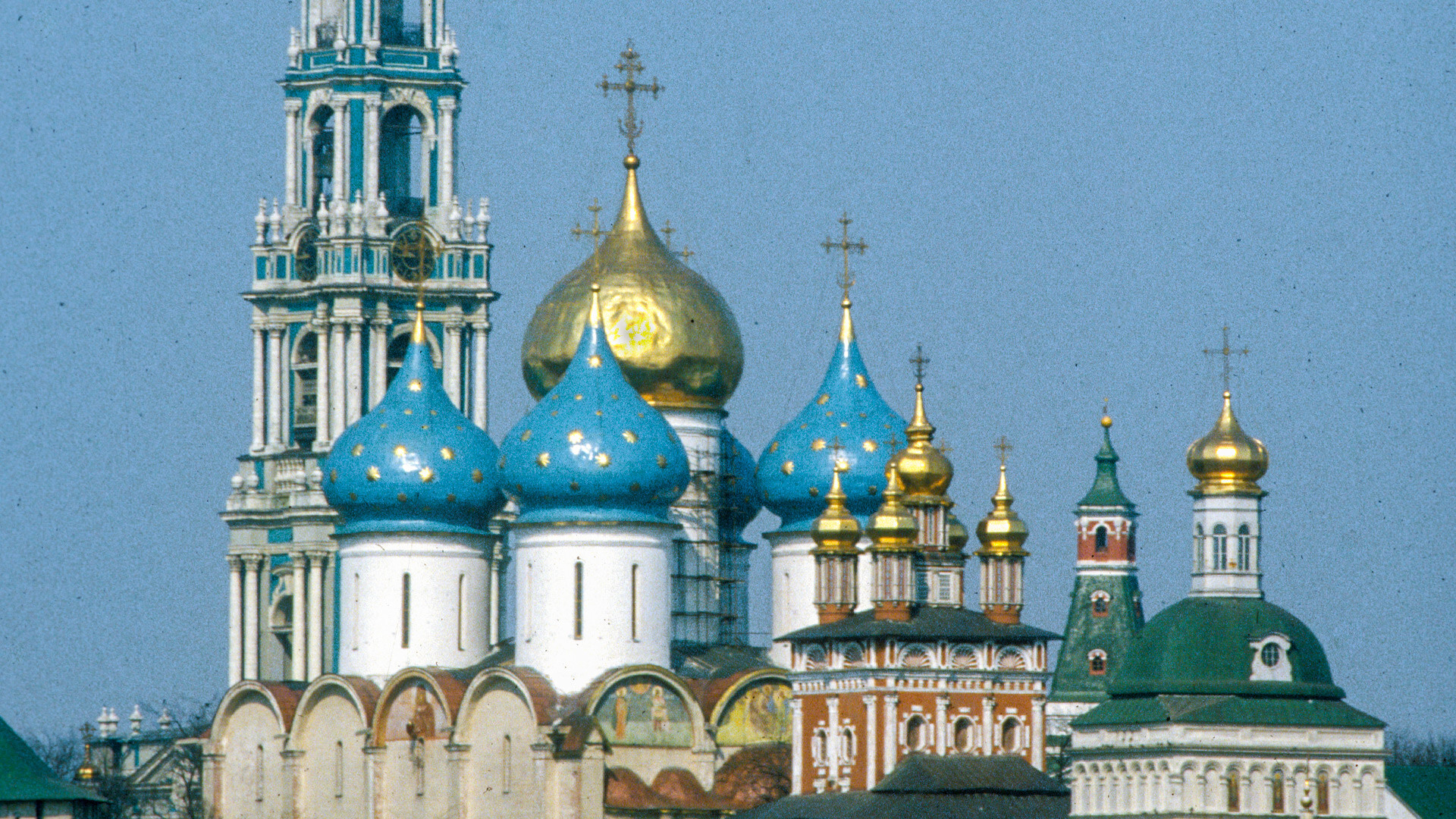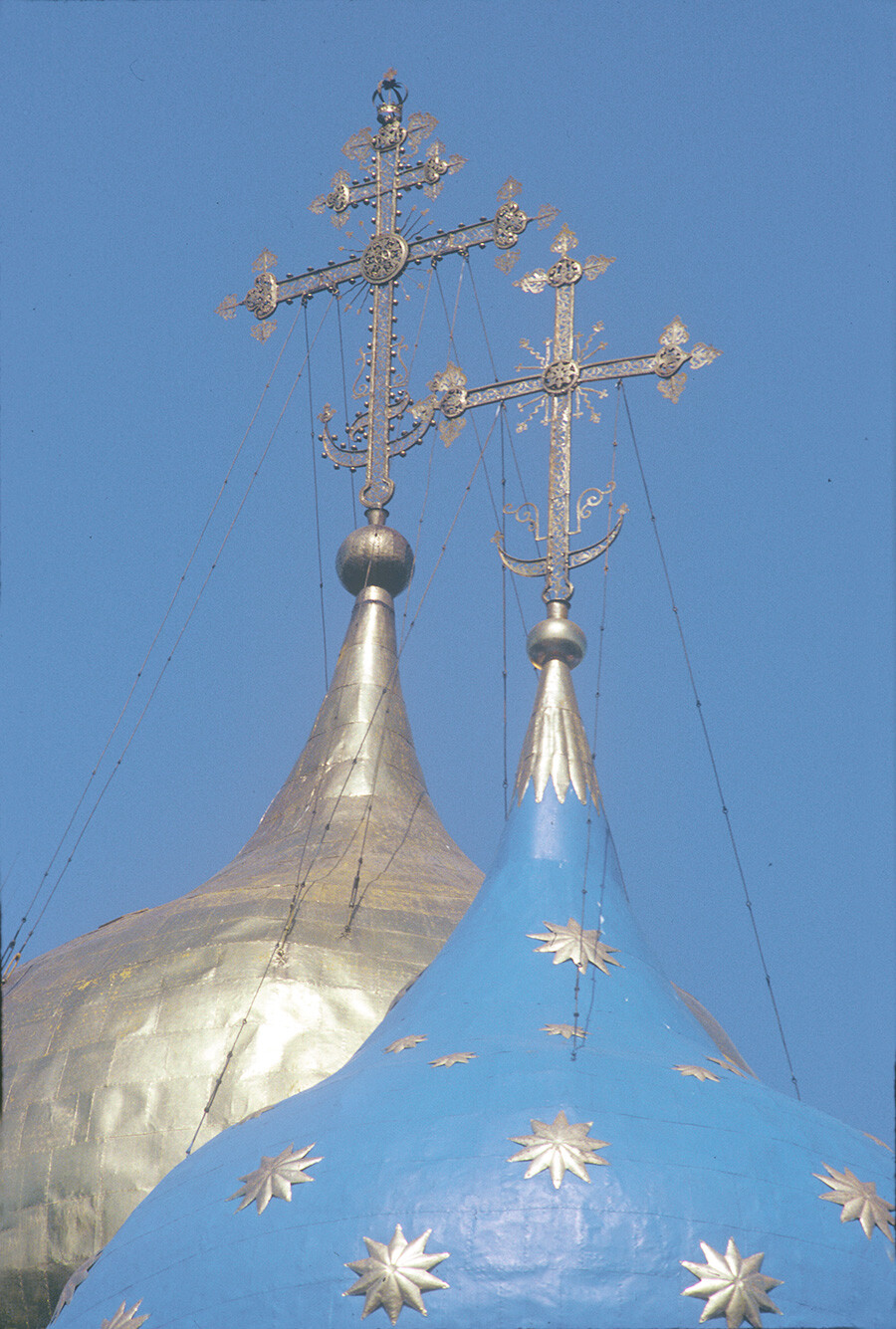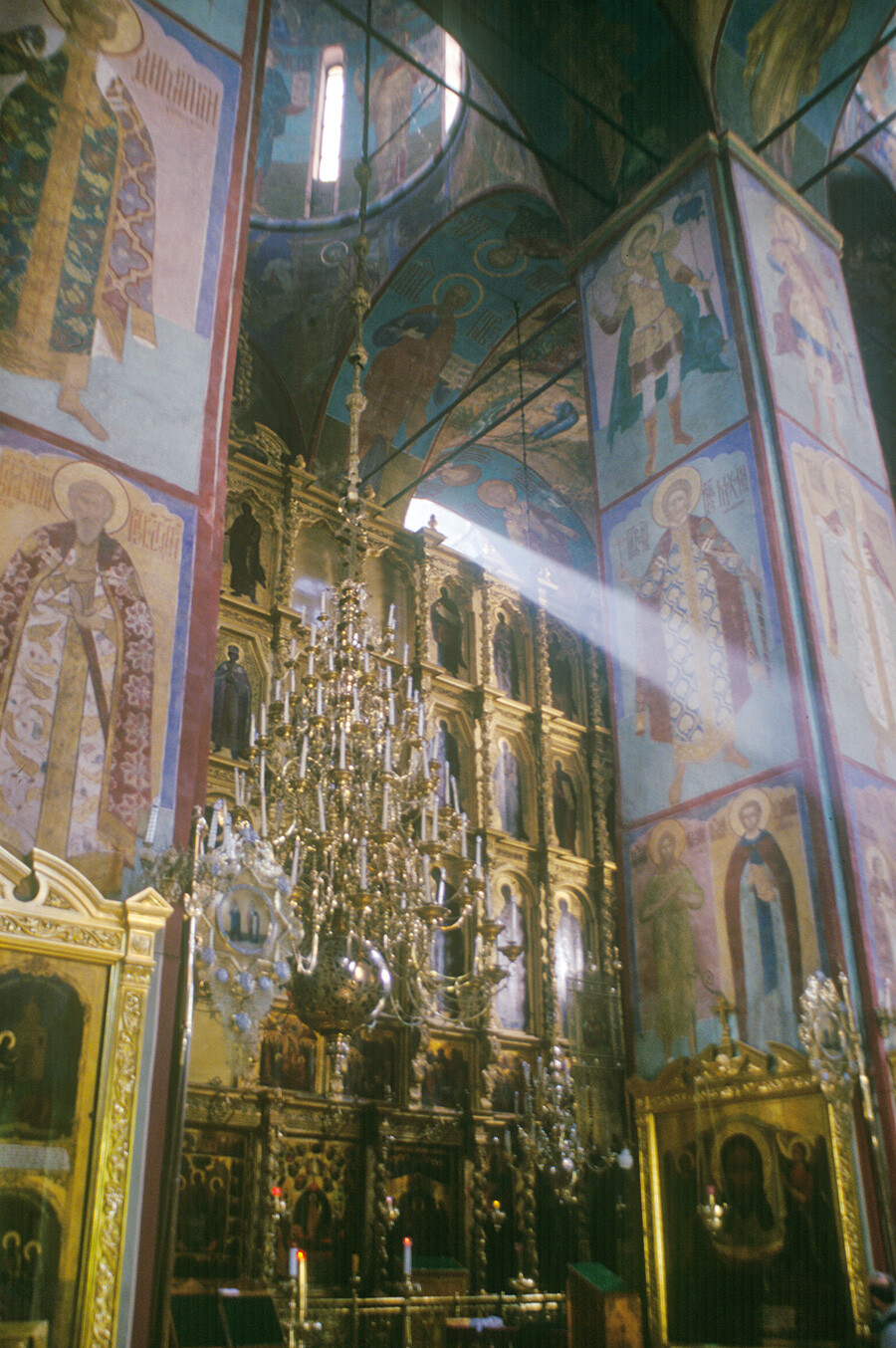Cathedrals of the Dormition: From the Moscow Kremlin to the Trinity-St. Sergius Monastery

 Sergiev Posad, Trinity-St. Sergius Monastery, southeast view. From left: Bell tower, Dormition Cathedral, Gate Church of Nativity of John the Baptist, Holy Gate & east wall. April 18, 1980
Sergiev Posad, Trinity-St. Sergius Monastery, southeast view. From left: Bell tower, Dormition Cathedral, Gate Church of Nativity of John the Baptist, Holy Gate & east wall. April 18, 1980
At the beginning of the 20th century, Russian chemist and photographer Sergey Prokudin-Gorsky developed a complex process for vivid color photography. His vision of photography as a form of education and enlightenment was demonstrated through his photographs of architectural monuments in the historic sites throughout the Russian heartland.
 Moscow Kremlin. Dormition Cathedral. Enthronement of Mikhail Romanov. Reproduction of 1673 illustration published in P. G. Vasenko, Romanov Boyars and the Enthronement of Mikhail Fedorovich (St. Petersburg, 1913).
Moscow Kremlin. Dormition Cathedral. Enthronement of Mikhail Romanov. Reproduction of 1673 illustration published in P. G. Vasenko, Romanov Boyars and the Enthronement of Mikhail Fedorovich (St. Petersburg, 1913).
He also established a business that produced color illustrations in books, such as a large volume released in 1913 for the Romanov dynasty tercentenary. In it, Prokudin-Gorsky reproduced watercolor miniatures made for an album presented in 1673 to Tsar Alexey Mikhailovich and devoted to events leading to the enthronement in 1613 of his father, Mikhail Fyodorovich, the first Romanov tsar.
 Moscow Kremlin. Dormition Cathedral, southeast view. June 17, 2012
Moscow Kremlin. Dormition Cathedral, southeast view. June 17, 2012
The reproductions include a depiction of the solemn coronation ceremony on July 11, 1613, in the Dormition Cathedral of the Moscow Kremlin. Primary artist Ivan Maksimov neglected to show the walls painted with frescoes, but the cathedral’s grand icon screen is depicted on the right side.
 Sergiev Posad, Trinity-St. Sergius Monastery. Dormition Cathedral, southeast view, Foreground: South monastery wall & St. Barbara Cloisters. May 29, 1999
Sergiev Posad, Trinity-St. Sergius Monastery. Dormition Cathedral, southeast view, Foreground: South monastery wall & St. Barbara Cloisters. May 29, 1999
Origins
For centuries, the golden-domed Dormition (Uspensky) Cathedral in the Moscow Kremlin was Russia’s most elevated monument, at the center of its history, its politics, its culture and its Orthodox religion. Even after the founding of St. Petersburg, the coronation ceremony of each ruler of Russia occurred in this cathedral, including the coronation of Nicholas II on May 26, 1896.
 Trinity-St. Sergius Monastery. Dormition Cathedral, west view. Right: Chapel over Dormition Well. December 13, 1979
Trinity-St. Sergius Monastery. Dormition Cathedral, west view. Right: Chapel over Dormition Well. December 13, 1979
The Dormition Cathedral is dedicated to one of the most venerated mysteries in Orthodox theology, the Dormition of the Virgin, which refers to the transposition of Mary from this world to the heavenly sphere. Orthodox iconography portrays the recumbent Mother of God, surrounded by apostles, as falling asleep – hence the term ‘dormition’ (in Russian ‘uspenie’) from the Latin verb ‘dormire’, “to sleep”. At this moment – in effect, Mary’s death – Christ accepts Mary’s soul into heaven three days before her “assumption”, in which her resurrected body is taken to heaven.
 Trinity-St. Sergius Monastery. Dormition Cathedral, south view. June 3, 1992
Trinity-St. Sergius Monastery. Dormition Cathedral, south view. June 3, 1992
The origins of the Kremlin Dormition Cathedral are closely connected with the rise of Moscow’s power. In 1326, the leading Russian church prelate, Metropolitan Peter of Vladimir, made the Moscow Kremlin his de facto residence. The prelate’s health was in decline and it was felt that the Moscow court could provide better care. This move, carefully cultivated by grand prince Ivan I (Kalita), was significant not only for the political and religious status of Moscow, but also for its architectural development.
 Trinity-St. Sergius Monastery. Dormition Cathedral, east view. May 15, 1995
Trinity-St. Sergius Monastery. Dormition Cathedral, east view. May 15, 1995
Conceived as a grand and solemn space for the crowning of Russian rulers and the investiture of metropolitans (later patriarchs) of the Russian Orthodox Church, Fioravanti's Cathedral of the Dormition represents the felicitous meeting of two cultures, Russian (with its Byzantine heritage) and western European as expressed in through the spirit of the Italian Renaissance.
 Trinity-St. Sergius Monastery. Dormition Cathedral, east facade, apsidal structure imitating design of Kremlin Dormition Cathedral. August 7, 1987
Trinity-St. Sergius Monastery. Dormition Cathedral, east facade, apsidal structure imitating design of Kremlin Dormition Cathedral. August 7, 1987
Imitating excellence
In Russia’s medieval history, the proliferation of imitations of the late 15th-century Dormition Cathedral in the Moscow Kremlin not only symbolized Muscovy’s gathering of the Russian lands, but also recreated in tangible form Moscow’s main shrine at strategic points throughout its expanding territory. Particularly important was the Dormition Cathedral at the Trinity-St. Sergius Monastery in Sergiev Posad, begun as a single retreat by St. Sergius of Radonezh in 1337 and gradually expanded to become the center of Muscovite monasticism.
 Trinity-St. Sergius Monastery. Dormition Cathedral, east facade, apse with central fresco of Old Testament Trinity. August 7, 1987
Trinity-St. Sergius Monastery. Dormition Cathedral, east facade, apse with central fresco of Old Testament Trinity. August 7, 1987
The Cathedral of the Dormition at the Trinity-Sergius Monastery was commissioned by Tsar Ivan IV (the Terrible), who, in 1559, personally attended the religious service initiating the project. In 1564, a disastrous fire that leveled much of the monastery delayed completion, as did the tsar’s mistrustful attitude toward the monastery hierarchy during the latter part of his reign. The church was not completed and consecrated until 1585, a year after Ivan’s death.
 Trinity-St. Sergius Monastery. Dormition Cathedral, cupolas & crosses, southwest view. June 3, 1992
Trinity-St. Sergius Monastery. Dormition Cathedral, cupolas & crosses, southwest view. June 3, 1992
Despite the century that separates them, the Dormition Cathedral at the Trinity-Sergius Monastery remains the most faithful re-creation of its Kremlin prototype on both interior and exterior. Although slightly larger than the Kremlin Dormition (29.2 meters by 42.3, as opposed to 27 meters by 39.75), it reproduces such distinctive structural details as a five-part apse merged within the pylons of the east facade, a large arcade band at mid-level, a uniform height for the semicircular gables (‘zakomary’), an equal division of the bays, and a large central drum and cupola. The cupolas were originally similar in shape to those of the Kremlin cathedral but were later replaced with higher onion domes.
 Trinity-St. Sergius Monastery. Dormition Cathedral. Central aisle, view southeast toward icon screen & south piers. Fresco of Dormition of Mary on ceiling vault. May 24, 1998
Trinity-St. Sergius Monastery. Dormition Cathedral. Central aisle, view southeast toward icon screen & south piers. Fresco of Dormition of Mary on ceiling vault. May 24, 1998
There are also obvious differences, such as cruciform piers rather than round columns that had enhanced the perception of interior space in the Moscow Dormition Cathedral, and the use of brick instead of limestone as the basic structural material. The proportions of the monastery cathedral are heavier and lack the renaissance-inspired harmony of the Kremlin cathedral. Yet the general similarity exists on the exterior and interior.
Interior fresco upgrade
 Trinity-St. Sergius Monastery. Dormition Cathedral. North aisle, northwest dome with fresco of Christ Emmanuel. Right: fresco of Dormition of Mary on ceiling vault. May 24, 1998
Trinity-St. Sergius Monastery. Dormition Cathedral. North aisle, northwest dome with fresco of Christ Emmanuel. Right: fresco of Dormition of Mary on ceiling vault. May 24, 1998
The frescoes that cover the interior walls were not painted until 1684 – a reflection of the troubled century following the completion of the cathedral. Once commissioned, the frescoes were completed in the remarkably short period of three months by a group of 35 painters headed by the Yaroslavl master Dmitry Grigorev – also known as Dmitry Grigorevich Plekhanov (By comparison, the frescoes of the Kremlin Dormition Cathedral were painted in 1642-43).
 Trinity-St. Sergius Monastery. Dormition Cathedral. View southeast toward icon screen & central dome. May 24, 1998
Trinity-St. Sergius Monastery. Dormition Cathedral. View southeast toward icon screen & central dome. May 24, 1998
Dmitry Grigorev (1642-ca. 1700) was one of the most accomplished Russian artists of the 17th century, a product of the great Yaroslavl school of icon painting. His other major projects include the interiors of the Archangel Cathedral in the Moscow Kremlin, the St. Sophia Cathedral in Vologda and the Dormition Cathedral in Rostov, which were severely defaced in the Soviet period.
 Trinity-St. Sergius Monastery. Dormition Cathedral. Central aisle with candelabra, view east toward central dome. Fresco of Dormition of Mary on ceiling vault. May 29, 1999
Trinity-St. Sergius Monastery. Dormition Cathedral. Central aisle with candelabra, view east toward central dome. Fresco of Dormition of Mary on ceiling vault. May 29, 1999
The fresco cycles on the walls and ceiling vaults of the Dormition Cathedral display a series of scenes focusing on the life of Christ and the Virgin Mary. Above all, prominence is given to the depiction of the cathedral festival, the Dormition of the Virgin, on the central ceiling vault in front of the main cupola.
 Trinity-St. Sergius Monastery. Dormition Cathedral. View east toward icon screen & central dome. May 24, 1998
Trinity-St. Sergius Monastery. Dormition Cathedral. View east toward icon screen & central dome. May 24, 1998
The frescoes on the massive piers are notable for their panoply of saintly Russian princes and church fathers, Byzantine as well as Russian. The bases of the piers display sacred images in large icon cases.
 Trinity-St. Sergius Monastery. Dormition Cathedral. Central aisle with candelabra, view east toward icon screen & central dome. Fresco of Dormition of Mary on ceiling vault. May 29, 1999
Trinity-St. Sergius Monastery. Dormition Cathedral. Central aisle with candelabra, view east toward icon screen & central dome. Fresco of Dormition of Mary on ceiling vault. May 29, 1999
The current magnificent gilded five-level icon screen was completed at the turn of the 18th century for 76 icons painted primarily in the late 17th century. The main aisle is graced with two bronze chandeliers of breathtaking craftsmanship made at the Kremlin Armory workshops in the 17th century.
Supporting structures
 Trinity-St. Sergius Monastery. Dormition Cathedral. Interior decorated with birch boughs in preparation for Trinity Day (Descent of Holy Spirit, 50 days after Easter). Green boughs symbolize resurrection. May 29, 1999
Trinity-St. Sergius Monastery. Dormition Cathedral. Interior decorated with birch boughs in preparation for Trinity Day (Descent of Holy Spirit, 50 days after Easter). Green boughs symbolize resurrection. May 29, 1999
Upon leaving the cathedral through the west portal and stepping back into Cathedral Square, one notices three other structures in the immediate vicinity of the west façade. Just to the southwest is the delightfully festive Dormition Chapel at the Sacred Well, erected toward the end of the 17th century over a well created at a spring that had appeared in 1644. The rich decorative style is often referred to as ‘Naryshkin Baroque’, after Peter the Great’s maternal family, who built several churches in the style at the turn of the 18th century. A few steps away is a decorative canopy over the spring outlet where visitors can partake of the sacred waters.
 Trinity-St. Sergius Monastery. Dormition Cathedral. West wall with depiction of sinners in hell, part of fresco of Last Judgement. May 29, 1999
Trinity-St. Sergius Monastery. Dormition Cathedral. West wall with depiction of sinners in hell, part of fresco of Last Judgement. May 29, 1999
Although modest in appearance, there is another important monument at the west façade of the Dormition Cathedral – the burial chapel of Tsar Boris Godunov, his wife, and their two children. This is not the place to explain the complicated history of his brief reign (1598-1605), filled with crises and rebellion or its disastrous aftermath.
 Trinity-St. Sergius Monastery. Dormition Cathedral. North wall with frescoes depicting Eucumenical Councils (bottom row), motifs from Akathist hymn to Virgin, & scenes from life of Christ. May 29, 1999
Trinity-St. Sergius Monastery. Dormition Cathedral. North wall with frescoes depicting Eucumenical Councils (bottom row), motifs from Akathist hymn to Virgin, & scenes from life of Christ. May 29, 1999
Suffice it to say that, upon the sudden death of Boris in April 1605, his 16-year-old son became Tsar Fyodor II and ruled for some six weeks before being overthrown by court intrigue and killed in June, together with his mother Maria. Only the following year were the three bodies properly re-interred at the Dormition Cathedral of the Trinity-St. Sergius Monastery.
 Trinity-St. Sergius Monastery. Chapel over Dormition Well, west view. June 3, 1992
Trinity-St. Sergius Monastery. Chapel over Dormition Well, west view. June 3, 1992
Fyodor’s sister, Xenia, was allowed to live, but was abused and then forced to enter a convent. Upon her death in 1622, her body was placed in the same crypt. The current small chapel was built in 1782 as a result of modifications to the west part of the Dormition Cathedral.
 Trinity-St. Sergius Monastery. Canopy over sacred spring (left) & Chapel over Dormition Well, west view. Background: Dormition Cathedral. June 3, 1992
Trinity-St. Sergius Monastery. Canopy over sacred spring (left) & Chapel over Dormition Well, west view. Background: Dormition Cathedral. June 3, 1992
The Trinity-St. Sergius Monastery contains many other shrines, including its early 15th-century Trinity Cathedral. These monuments, rich in history, will be explored in later articles for the ‘Discovering Russia’ series.
 Trinity-St. Sergius Monastery. Burial chapel said to contain remains of Boris Godunov, his wife Maria & their two children. Background: Dormition Cathedral, west facade. August 7, 1987
Trinity-St. Sergius Monastery. Burial chapel said to contain remains of Boris Godunov, his wife Maria & their two children. Background: Dormition Cathedral, west facade. August 7, 1987
In the early 20th century, the Russian photographer Sergey Prokudin-Gorsky developed a complex process for color photography. Between 1903 and 1916, he traveled through the Russian Empire and took over 2,000 photographs with the process, which involved three exposures on a glass plate. In August 1918, he left Russia and ultimately resettled in France where he was reunited with a large part of his collection of glass negatives, as well as 13 albums of contact prints. After his death in Paris in 1944, his heirs sold the collection to the Library of Congress. In the early 21st century, the Library digitized the Prokudin-Gorsky Collection and made it freely available to the global public. A few Russian websites now have versions of the collection. In 1986, the architectural historian and photographer William Brumfield organized the first exhibit of Prokudin-Gorsky photographs at the Library of Congress. Over a period of work in Russia beginning in 1970, Brumfield has photographed most of the sites visited by Prokudin-Gorsky. This series of articles juxtaposes Prokudin-Gorsky’s views of architectural monuments with photographs taken by Brumfield decades later.

